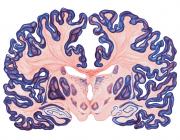Neural representations of faces and body parts in macaque and human cortex: a comparative FMRI study.
Publication Year
2009
Type
Journal Article
Abstract
Single-cell studies in the macaque have reported selective neural responses evoked by visual presentations of faces and bodies. Consistent with these findings, functional magnetic resonance imaging studies in humans and monkeys indicate that regions in temporal cortex respond preferentially to faces and bodies. However, it is not clear how these areas correspond across the two species. Here, we directly compared category-selective areas in macaques and humans using virtually identical techniques. In the macaque, several face- and body part-selective areas were found located along the superior temporal sulcus (STS) and middle temporal gyrus (MTG). In the human, similar to previous studies, face-selective areas were found in ventral occipital and temporal cortex and an additional face-selective area was found in the anterior temporal cortex. Face-selective areas were also found in lateral temporal cortex, including the previously reported posterior STS area. Body part-selective areas were identified in the human fusiform gyrus and lateral occipitotemporal cortex. In a first experiment, both monkey and human subjects were presented with pictures of faces, body parts, foods, scenes, and man-made objects, to examine the response profiles of each category-selective area to the five stimulus types. In a second experiment, face processing was examined by presenting upright and inverted faces. By comparing the responses and spatial relationships of the areas, we propose potential correspondences across species. Adjacent and overlapping areas in the macaque anterior STS/MTG responded strongly to both faces and body parts, similar to areas in the human fusiform gyrus and posterior STS. Furthermore, face-selective areas on the ventral bank of the STS/MTG discriminated both upright and inverted faces from objects, similar to areas in the human ventral temporal cortex. Overall, our findings demonstrate commonalities and differences in the wide-scale brain organization between the two species and provide an initial step toward establishing functionally homologous category-selective areas.
Keywords
Journal
J Neurophysiol
Volume
101
Pages
2581-600
Date Published
05/2009
ISSN Number
0022-3077
Alternate Journal
J. Neurophysiol.
PMID
19225169

